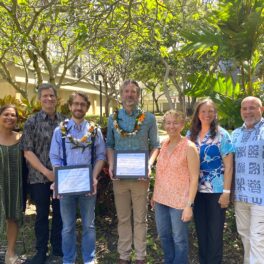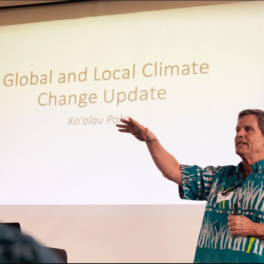Future ocean warming boosts tropical rainfall extremes
 Global ocean warming pattern and change in year-to-year rainfall variability. (Left) Predicted change of ocean surface temperature in 2050-2099 relative to 1950-1999 using an ensemble of climate models. (Right) Predicted change in amplitude of rainfall fluctuations (year-to-year standard deviation) in 2050-2099 relative to 1950-1999.
Credit: Kyung-Sook Yun.
Global ocean warming pattern and change in year-to-year rainfall variability. (Left) Predicted change of ocean surface temperature in 2050-2099 relative to 1950-1999 using an ensemble of climate models. (Right) Predicted change in amplitude of rainfall fluctuations (year-to-year standard deviation) in 2050-2099 relative to 1950-1999.
Credit: Kyung-Sook Yun.
Ocean warming is predicted to cause a twofold increase in amplitude of rainfall fluctuations over the tropical Pacific according to a new study published in Communications Earth & Environment co-authored by SOEST assistant professor of oceanography, Malte Stuecker.
The El Niño-Southern Oscillation (ENSO) is the most energetic naturally occurring year-to-year variation of ocean temperature and rainfall on our planet. The irregular swings between warm and wet “El Niño” conditions in the equatorial Pacific and the cold and dry “La Niña” state influence weather conditions worldwide, with impacts on ecosystems, agriculture and economies.
Climate models predict that the difference between El Niño- and La Niña-related tropical rainfall will increase over the next 80 years, even though the temperature difference between El Niño and La Niña may change only very little in response to global warming. The recent study uncovers the reasons for this surprising fact.
Using the latest crop of climate models, researchers from the IBS Center for Climate Physics at Pusan National University, the Korea Polar Research Institute, the University of Hawaiʻi at Mānoa, and Environment and Climate Change Canada, worked together to unravel the mechanisms involved.
“All climate models show a pronounced intensification of year-to-year tropical rainfall fluctuations in response to global warming,” said lead author Dr. Kyung-Sook Yun from the IBS Center for Climate Physics. “Interestingly the year-to-year changes in ocean temperature do not show such a clear signal. Our study therefore focuses on the mechanisms that link future ocean warming to extreme rainfall in the tropical Pacific.”
The research team found that the key to understanding this important climatic feature lies in the relationship between tropical ocean surface temperature and rainfall. There are two important aspects to consider: 1) the ocean surface temperature threshold for rainfall occurrence, and 2) the rainfall response to ocean surface temperature change, referred to as rainfall sensitivity.
“In the tropics, heavy rainfall is typically associated with thunderstorms and deep clouds shaped like anvils,” said Stuecker. “These only form once the ocean surface is warmer than approximately 27.5 degrees Celsius or 81 degrees Fahrenheit in our current climate.”
This ocean surface temperature threshold for intense tropical rainfall shifts towards a higher value in a warmer world and does not contribute directly to an increase in rainfall variability.
“However, a warmer atmosphere can hold more moisture which means that when it rains, rainfall will be more intense,” said June-Yi Lee, co-lead author and professor from IBS Center for Climate Physics. “Moreover, enhanced warming of the equatorial oceans leads to upward atmospheric motion on the equator. Rising air sucks in moist air from the off-equatorial regions, which can further increase precipitation, in case other meteorological conditions for a rain event are met.”
This increase in rainfall sensitivity is the key explanation why there will be more extreme ENSO-related swings in rainfall in a warmer world.
Story courtesy of Institute for Basic Science.



